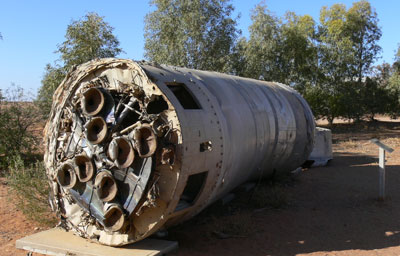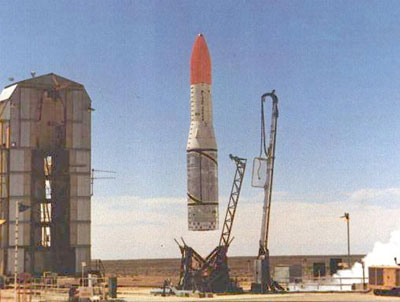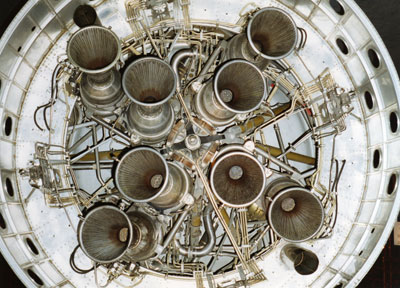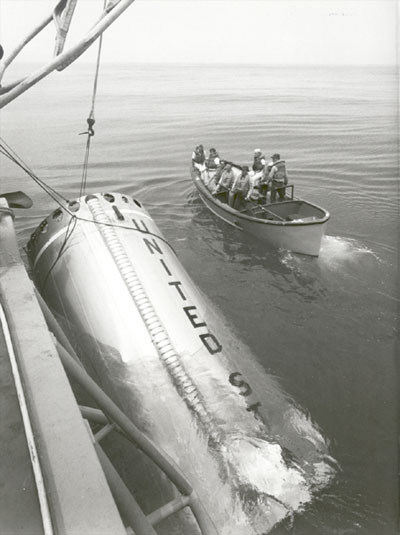|
Author
|
Topic: Locating and recovering spent rocket stages
|
Jay
Member Posts: 82
From: Bloomington, Illinois, USA
Registered: May 2005
|
 posted 12-06-2007 01:58 PM
posted 12-06-2007 01:58 PM
   
quote:
Originally posted by heng44:
J.L. Pickering sends this photo, but I'll let him provide the details.
Greetings... I just noticed that Ed had posted the mystery photo. I took this photo early in 1978 at the Alabama Space and Rocket Center. Word at the time was that filming on a science fiction movie had just wrapped up the week before. Most of the outdoor displays in the near vicinity of the visitors center had been decked out in a fashion similar to the F-1 shown here. It was a very strange sight to see. I can remember being curious at the time as to whether or not this sort of thing was really such a good idea. Anyway, I had to laugh when I saw this thread. If by some miracle an F-1 had survived the water impact, I suspect this might be a best case recovery scenario. |
CNewport
Member Posts: 13
From: Potomac, MD USA
Registered: Nov 2005
|
 posted 12-06-2007 10:04 PM
posted 12-06-2007 10:04 PM
  
quote:
Originally posted by mjanovec:
I assume it's the great depth of the ocean that keeps these boosters from "turning up."
The Saturn stages could certainly be found, but it is deep water and would be an expensive undertaking. However, doing an 18,000 lift from 5,000 m of water can be done, with the right equipment. At that water depth, the wreckage would be pretty well preserved.Does anyone on here know any millionaires? Richard Garriot probably has the cash and I actually do know him a little (we both dove in the Mir sub on an 1810 shipwreck found during the LB7 search). But he may be blowing his disposable money on his upcoming trip to the ISS. quote:
Originally posted by nasamad:
I'm just wondering if you have any plans or have had any (times are tough for an ROV pilot!) of trying to recover Helicopter 66 (Apollo's 8, 10, 11, 12, 13) from its watery grave?
Regarding the helo, again, it can be done. If it was in only 250 fsw, I am not sure how much would be left as things deteriorate pretty quickly in shallow water. However, if it was in over 1,000 fsw, the general structure should be intact, beyond what damage was done during the water impact. From what I remember, this was a large helicopter but we recover Blackhawks on a regular basis and they weigh 16,000 lbs in air. The key would be to get the Navy (i.e., SUPSALV) to do it when they already have an operation scheduled in the area. The Navy recently lost a Blackhawk off North Island in San Diego and there is a search team looking for that right now. Recovering another target during an on-going operation is a decision that would be left to the Navy and its always a matter of funding. Typically, helo recoveries are paid for by the military branch that lost the aircraft. If they do not have any compelling reason to recover something then they are not going to spend the money to do it. If anyone on this site knows the approximate crash location, I can check our charts and at least see what the water depth is. In the end, it is always about paying for it all and if Mike Quattrone at the Discovery Channel had not agreed to take the financial risk, Grissom's spacecraft would most certainly still be on the ocean floor. I am actually in San Diego right now helping NAVSEA test their new submarine rescue system but if someone can give me a position, we can look easily look it up on our nav computer and at least see where the crash location is. |
astropat
New Member Posts: 6
From:
Registered: Dec 2007
|
 posted 12-15-2007 06:31 PM
posted 12-15-2007 06:31 PM
   
quote:
Originally posted by Obviousman:
There were some interesting pics of a Titan that had been recovered off Florida.
When I was at Space Camp in 1983 there was what they called the first stage of the GT-5 rocket. I was surfing the Field Guide of American Spacecraft and in this picture, right next to the Skylab trainer, it is sitting out in the open in a parking lot at the Space and Rocket Center. |
MrSpace86
Member Posts: 1618
From: Gardner, KS
Registered: Feb 2003
|
 posted 01-08-2008 12:33 AM
posted 01-08-2008 12:33 AM
   
So is the Sputnik booster and Yuri Gagarin's historical Vostok booster easier to recover than the Saturns? I mean, they did land somewhere in the Siberian desert. Any info or thoughts on these spent boosters? |
mikej
Member Posts: 481
From: Germantown, WI USA
Registered: Jan 2004
|
 posted 02-18-2009 10:04 AM
posted 02-18-2009 10:04 AM
   
I recently posted pictures of this F-1, noted that the engine had starred in a movie, and included a link back to this thread.A coworker read the page, thought he recognized the picture, and produced a link to the 1979 movie called Ravagers. If you scroll down to the "Fun Stuff" section, it notes
The "abandoned missile base" in the movie is actually the Alabama Space and Rocket Center museum and the "Rocket Park" in the back lot of the museum. Anyone with NetFlix want to rent it and post a review? Warning: it only got 3.8/10 stars on IMDB.  |
liftoff
Member Posts: 46
From: Watt, Switzerland
Registered: Jun 2008
|
 posted 05-17-2009 12:02 PM
posted 05-17-2009 12:02 PM
   
Does anyone know if any of the Saturn V first stages have ever been recovered? Or are they still on the ground of the Atlantic Ocean?Editor's note: Threads merged. |
Lou Chinal
Member Posts: 1332
From: Staten Island, NY
Registered: Jun 2007
|
 posted 05-17-2009 06:46 PM
posted 05-17-2009 06:46 PM
   
To my knowledge no, but I have been wrong before. The only three I know of is one in Texas, one in Alabama, and one in Florida. There are various parts all over the country.Usually cost becomes the obstacle in exhibiting a large item (such as a Titan). |
Blackarrow
Member Posts: 3160
From: Belfast, United Kingdom
Registered: Feb 2002
|
 posted 08-15-2011 11:13 PM
posted 08-15-2011 11:13 PM
  
Has no one ever tried to locate any of the Saturn V S1C first stages on the bed of the Atlantic? I imagine forty years of immersion in salt water would have taken its toll, but there must still be evidence. (As a slight aside, the only example I can think of of a rocket-stage which put a nation's first satellite into orbit and survived the fall after separation and can be viewed today is the first stage of the UK Black Arrow rocket, which is displayed in Australia. Slightly the worse for wear, but identifiable.) Editor's note: Threads merged. |
AusSpace
Member Posts: 25
From: Adelaide, South Australia, Australia
Registered: Nov 2010
|
 posted 08-15-2011 11:15 PM
posted 08-15-2011 11:15 PM
   
I'm not 100% sure, but I don't think the Black Arrow stage on display is flown. It's in near pristine condition. Perhaps it's displayed some ware else? There is a Blue Streak stage on display that was recovered from the Simpson Desert in 1994, however the dummy satellite onboard was also recovered so I guess it never made orbit. One of its Rolls Royce RZ2 engines has survived almost intact. Also, there is the first stage of the Redstone that put Australia's first satellite, WRESAT into orbit in November 1967. It was recovered from the Simpson in 1990. I have a friend who works under contract on the Woomera Prohibited Area who obtained for me several small pieces of the RZ2 and Redstone that where only going to be disposed of a little over a year ago. |
Blackarrow
Member Posts: 3160
From: Belfast, United Kingdom
Registered: Feb 2002
|
 posted 08-16-2011 06:31 PM
posted 08-16-2011 06:31 PM
  
No, the pictures referred to by AusSpace do not show the rocket-stage to which I was referring. The first stage of Black Arrow X3, which launched the UK's "Prospero" satellite on 28th October, 1971, was recovered from Anna Creek Station in South Australia and is now on display at Memorial Park, William Creek ("population 6") in South Australia. It's in remarkable condition. The eight engine-bells appear to have taken the brunt of the impact, but can easily be compared with the engines on the unflown X4 which is in the Science Museum, London.  

|
Space Cadet Carl
Member Posts: 225
From: Lake Orion, Michigan
Registered: Feb 2006
|
 posted 08-18-2011 10:00 AM
posted 08-18-2011 10:00 AM
   
Interesting topic. I always assumed that a Saturn V first stage (S-1C) hit the ocean totally intact and NASA would go to great lengths to inform any ships and aircraft to clear out. Boy, was I ever wrong! Now you're telling me that the S-1C desintegrated on the way back down and pieces rained down on a ship. That's amazing. |
tfrielin
Member Posts: 162
From: Athens, GA
Registered: Feb 2007
|
 posted 08-18-2011 02:23 PM
posted 08-18-2011 02:23 PM
  
There is no way an S-IC stage could have stayed intact after separation. It was 38 miles up with a velocity of 5,500 MPH. It was not dynamically stable so it would have tumbled as it came down, causing it to break up under the aerodynamic stresses. All that remains on the ocean floor is F-1 engines and maybe a semi-intact LOX or RP-1 tank. But not a whole, intact stage. |
moorouge
Member Posts: 2458
From: U.K.
Registered: Jul 2009
|
 posted 08-18-2011 04:15 PM
posted 08-18-2011 04:15 PM
   
Not a Saturn, but somewhere there is a photo of a US Navy vessel recovering an eighteen foot section of a Titan stage following one of the Gemini launches. |
Robert Pearlman
Editor Posts: 43576
From: Houston, TX
Registered: Nov 1999
|
 posted 08-18-2011 04:51 PM
posted 08-18-2011 04:51 PM
   
The stage you mention is from Gemini 5 (and as discussed earlier in this thread, is at the U.S. Space and Rocket Center in Alabama today). |
mikej
Member Posts: 481
From: Germantown, WI USA
Registered: Jan 2004
|
 posted 08-18-2011 05:39 PM
posted 08-18-2011 05:39 PM
   
The folks at Marshall were fairly optimistic about the survivability of S-IC components prior to SA-501's launch.The Apollo 4 Press Kit (direct link to 10.8 meg PDF) contains the following: Stationed downrange in the Atlantic in the 300-400-mile range from Cape Kennedy will be recovery ships and planes to locate and recover two camera capsules and to serve as a spacecraft recovery team if there should be an aborted mission. A secondary requirement will be the sighting and recovery, if possible, of the S-IC booster or any portion surviving re-entry and impact. An LPD (landing platform dock) will be in the immediate area in which the cameras and booster are expected to impact. Helicopters launched from the ship's heliport will search for the camera capsules ejected some 38 seconds after first and second-stage first-plane separation. Impact point should be some 470 miles from the launch site. These personnel and those in Air Force planes in the area will also attempt to sight the booster and photograph the impact. Should any portion of the booster survive the impact and float, the LPD will attempt a recovery. Two Marshall center representatives will be on the ship to identify components and decide if they may be safely recovered. The LPD's lower section may be flooded to allow large sections to be hauled aboard. Should the draft of any floating component be too great for the ship, alternate procedures call for towing it to the nearest land and beaching the component. The booster reentry sighting-and-recovery exercise is being conducted to support an advanced missions study on recovering and refurbishing large space vehicles.
This optimism was short-lived, however, as Apollo 6's press kit makes no mention of S-IC recovery.The November 29, 1967 Marshall Star has a story: S-IC Booster Break-Up Left Foam & Fuel SlickThe 138-foot-long S-IC booster, which lifted the Apollo/Saturn V from the launch pad at the Kennedy Space Center earlier this month, broke into many pieces as it re-entered the earth's atmosphere. Engineers at the Marshall Center had predicted the break-up after the powered flight phase. They hoped, however, that some of the pieces would float on the ocean's surface and could be re trieved for laboratory analysis. Jack Roach of the Propulsion and Vehicle Engineering Laboratory said "thousands" of small pieces of lightweight foam were found floating in the impact area about 350 miles downrange of the launch site and some were recovered. No metal parts were picked up, however, from the booster. A fuel slick was sighted near the debris and Roach said that it probably marked the spot where the huge booster's fuel tanks entered the water. Three second stage ullage rocket fairings were also recovered. The fairings are made of fiberglass honeycomb. The most important components picked up in the Atlantic were two camera cassettes, which ejected from the second stage of the rocket as planned. They recorded "excellent" motion picture footage of the first stage separation and the critical interstage separation, Roach said. He said a Dept. of Defense helicopter crew picked up the camera packages about 60 miles from the probable booster impact point. Roach was aboard a helicopter in the impact area to certify the safety of any booster components picked up by recovery forces. He said an airplane with radar tracked the re-entry of the huge booster from a very high altitude. After boosting the rocket toward space, the booster cut off at an altitude of about 38 miles. Momentum carried it up to about 70 miles after separation. Then it arched over for the plunge toward the ocean. Radar showed that the spent vehicle broke up at an altitude of about 24,000 to 30,000 feet. Engineers would not speculate as to why it came apart at that point. They said it was probably oscillating very rapidly as it fell into the dense atmosphere. The pilot of another airplane reported that he was watching the re-entry and saw the vehicle break into many pieces. The radar aboard the second plane confirmed the break-up. Roach said the P&VE Materials Division is studying the recovered foam to identify its location on the vehicle. MSFC engineers hoped that some pieces could be recovered so they could assess impact damage and salt water effects on mechanical parts. |
Robert Pearlman
Editor Posts: 43576
From: Houston, TX
Registered: Nov 1999
|
 posted 03-28-2012 03:43 PM
posted 03-28-2012 03:43 PM
   
For discussion of Bezos Expeditions' F-1 Engine Recovery project, please see: Amazon founder finds Apollo 11 F-1 engines |
Tykeanaut
Member Posts: 2216
From: Worcestershire, England, UK.
Registered: Apr 2008
|
 posted 01-11-2013 04:25 AM
posted 01-11-2013 04:25 AM
   
There was a report about space debris on the BBC2's Stargazing Live show last night.It was said that some of the Apollo rocket stages were still in orbit, surely not? |
Robert Pearlman
Editor Posts: 43576
From: Houston, TX
Registered: Nov 1999
|
 posted 01-11-2013 06:19 AM
posted 01-11-2013 06:19 AM
   
A number of the S-IVB stages are still in heliocentric orbit, including from Apollo 8, Apollo 9, Apollo 10, Apollo 11 and Apollo 12. Apollo 12's stage was spotted by astronomers in 2002. |
moorouge
Member Posts: 2458
From: U.K.
Registered: Jul 2009
|
 posted 01-11-2013 08:09 AM
posted 01-11-2013 08:09 AM
   
According to the website (Wikipedia) quoted by Robert above, the Apollo 7 S-1VB stage is in heliocentric orbit. How? |
Robert Pearlman
Editor Posts: 43576
From: Houston, TX
Registered: Nov 1999
|
 posted 01-11-2013 08:25 AM
posted 01-11-2013 08:25 AM
   
The Apollo 7, Skylab and ASTP listings on Wikipedia's chart are in error. I can't quickly find a date for Apollo 7's S-IVB reentry, but Apollo-Soyuz's stage was deorbited into the Pacific Ocean on the evening of July 15, 1975 (for example). |
Jay Chladek
Member Posts: 2272
From: Bellevue, NE, USA
Registered: Aug 2007
|
 posted 01-11-2013 09:12 AM
posted 01-11-2013 09:12 AM
   
Did they actually do an engine restart to get Apollo 9's S-IVB into a higher orbit after Spider was extracted? I don't recall ever reading anything like that (you figure if it was fully fueled with it being a Saturn V launch, I suppose it might have been possible).I remember chatting with Tom Jones and Dan Durda at Spacefest last year about an idea I had for a possible "test" mission before an Orion asteroid flight where one of the old S-IVB stages from Apollos 8 through 12 could be used as a rendezvous target. The idea would be to perhaps inspect and recover some samples from one as an example of a Long Duration Exposure Facility on steriods. Where else would you get samples from something drifting around in space outside the Van Allen belts for over four decades? The idea would be rather than flying a months long mission, this one could perhaps be half as long and would make for a nice test of equipment and procedures with a relatively known object. I could tell I got the gears turning in Tom's head as I discussed the idea (he had an idea of using it as an item with a known mass to test out asteroid deflection techniques), but Dan didn't think it was possible since the flight path of these things would be practically unpredictible with all the gravitational fields they have encountered, making the margin of error to detect them very high. I understand that point, but I figure some smart mathematicians just need to come up with some better ways to account for the gravity fields, crunch the numbers and then partner with some telescopes to try and search the sky for possible targets. As I recall, there were some numbers crunched for Apollo 12's S-IVB which in combination with computer simulations showed where it was and where it might be during a two year period after it was detected a few years back. |
Robert Pearlman
Editor Posts: 43576
From: Houston, TX
Registered: Nov 1999
|
 posted 01-11-2013 09:23 AM
posted 01-11-2013 09:23 AM
   
quote:
Originally posted by Jay Chladek:
Did they actually do an engine restart to get Apollo 9's S-IVB into a higher orbit after Spider was extracted?
According to the NSSDC Master Catalog: On 3 March 1969 the S-IVB stage made a third burn to put it into a solar orbit. |
Tykeanaut
Member Posts: 2216
From: Worcestershire, England, UK.
Registered: Apr 2008
|
 posted 01-11-2013 09:46 AM
posted 01-11-2013 09:46 AM
   
Are they wrong on the tv, they seemed to indicate that some were in orbit aound the Earth? |
Robert Pearlman
Editor Posts: 43576
From: Houston, TX
Registered: Nov 1999
|
 posted 01-11-2013 09:54 AM
posted 01-11-2013 09:54 AM
   
To my knowledge, no Apollo/Saturn stages remain in Earth orbit. After 40+ years, were they not directed to reenter, their orbits would have decayed to the same end. |
Rusty B
Member Posts: 239
From: Sacramento, CA
Registered: Oct 2004
|
 posted 01-11-2013 04:09 PM
posted 01-11-2013 04:09 PM
   
quote:
Originally posted by moorouge:
Not a Saturn, but somewhere there is a photo of a US Navy vessel recovering an eighteen foot section of a Titan stage following one of the Gemini launches.
Here's a picture, in The Southeast Missourian newspaper - Aug 26, 1965, of the Gemini V booster on the deck of the recovery ship. |
dtemple
Member Posts: 730
From: Longview, Texas, USA
Registered: Apr 2000
|
 posted 01-11-2013 04:11 PM
posted 01-11-2013 04:11 PM
   
quote:
Originally posted by moorouge:
According to the website (Wikipedia) quoted by Robert above, the Apollo 7 S-1VB stage is in heliocentric orbit. How?
According to the website Heavens Above, Apollo 7's S-IVB reentered the atmosphere on Oct. 18, 1968. quote:
Originally posted by Robert Pearlman:
According to the NSSDC Master Catalog: On 3 March 1969 the S-IVB stage made a third burn to put it into a solar orbit.
According to the Heavens Above website, Apollo 9's S-IVB is, in fact, in solar orbit. |
space-E
Member Posts: 19
From: Eugene, OR, USA
Registered: May 2012
|
 posted 03-21-2013 08:23 PM
posted 03-21-2013 08:23 PM
   
I don't know if this is old or new news for you, but they've found some of the old stages... |
Robert Pearlman
Editor Posts: 43576
From: Houston, TX
Registered: Nov 1999
|
 posted 03-21-2013 09:00 PM
posted 03-21-2013 09:00 PM
   
Please see: Amazon founder recovers Apollo F-1 engines |
















